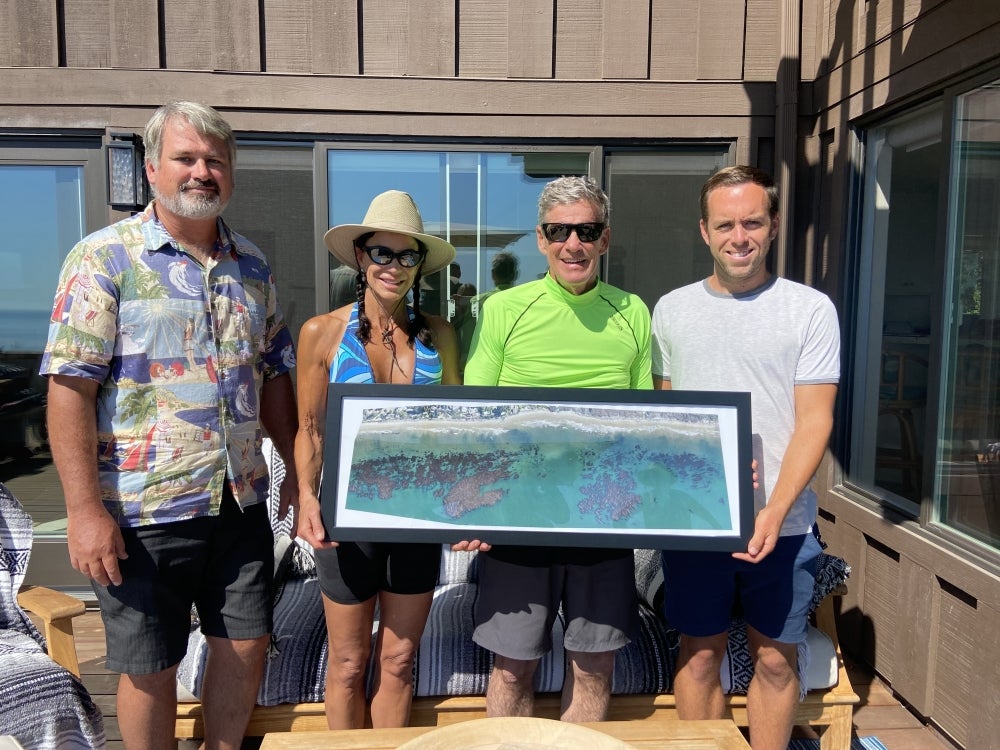
Serendipity on the Shore
For marine ecologist Kyle Emery, it was just another day on the job. Surveying the beach and kelp forest at Arroyo Quemada with his trusty drone, he was conducting research at a Santa Barbara Coastal Long-Term Ecological Research (SBC LTER) site, where scientists regularly measure the productivity and condition of the giant kelp stands and the organisms that live among them.
Little did Emery know that a casual conversation with a trio of people strolling on the sand would result in a generous gift to the LTER and related kelp forest research.
“As I was surveying, a couple and their friend approached me and asked some questions about the project and what research is going on at the site, out in the kelp forest and on the beach,” recalled Emery, a UC Santa Barbara Ph.D. graduate turned NSF Ocean Sciences postdoctoral fellow now based at UCLA . Ever the friendly researcher with a knack for public engagement, Emery told them about the kelp beds and the creatures that rely on them and on the kelp wrack that washes onshore, as well as the mission of the LTER to understand kelp forest ecology.
“They were curious about the project in general, and they mentioned being interested, and if they could learn more and contribute,” Emery said. “I talk to people while doing fieldwork all the time, but rarely do I encounter folks interested in becoming more involved.”
The couple, it turns out, included Bradford Jones — co-founder of venture capital firm Redpoint Ventures — and his partner, Julie Black. Their contribution? A $3 million gift to establish the Santa Barbara Coastal Research Fund, an endowment created to support SBC LTER leadership, undergraduate scholars, graduate and postdoctoral fellows and program operations. The funds will also go toward expanding research at the LTER and related work at UCSB’s Marine Science Institute.
“The ocean around Santa Barbara is a special place,” Jones said. “It is home to abundant sea life, from kelp beds to dolphins. It is an amazing experience to kayak along the coast and experience them up close.
“Whenever we visit our second home in North Goleta, we walk along the beach and kayak in the water,” he continued. “Protecting this coastal stretch is very important to us, and enhancing our understanding of the coast is integral to protecting it.”
“This gift will allow us to elevate the science in the project by enabling us to recruit new talent and to focus more on doing novel, cutting-edge science,” said Robert Miller, SBC LTER director. “It’s been a real pleasure to connect with Brad and Julie, and their generosity is testament to their value of the natural world and science, as well as the people that do it.”
Established by the National Science Foundation, the SBC LTER is one part of a network of long-term ecological research sites created around the world. Research at these sites is conducted with the goal of generating freely available, long-term datasets that give scientists the context for short-term studies, allow them to tease out long-term trends, and answer questions that are of ecological importance to each individual site. The SBC LTER, for instance, focuses on the site’s kelp forests that underlie diverse communities of fish, crustaceans, mammals and birds that live in the water and on the nearby shores. As climate change shifts the conditions in the oceans, understanding how it affects marine and coastal ecosystems becomes ever more crucial.
“There are so many new things we have yet to discover about the kelp forests of the Santa Barbara Coastal LTER and the many connections it has with the coast,” said UC Santa Barbara Vice Chancellor for Research Joe Incandela. “Thanks to this generous gift from Bradford Jones and Julie Black, our researchers will be able to further expand our knowledge of this wild and beautiful ecosystem that is important to all of us.”
For Emery, and the present and future SBC LTER researchers who will benefit from the gift, it’s an encouraging and empowering sign of support for their endeavors.
“It’s just really nice to be able to connect with the people who live where we do our research,” he said. “They have a totally different connection to the site, but it’s just as important to them as it is to us. I was just blown away that they would be willing to make a contribution like that because of what the place means to them, and it’s really amazing to think what we can now do moving forward.”



